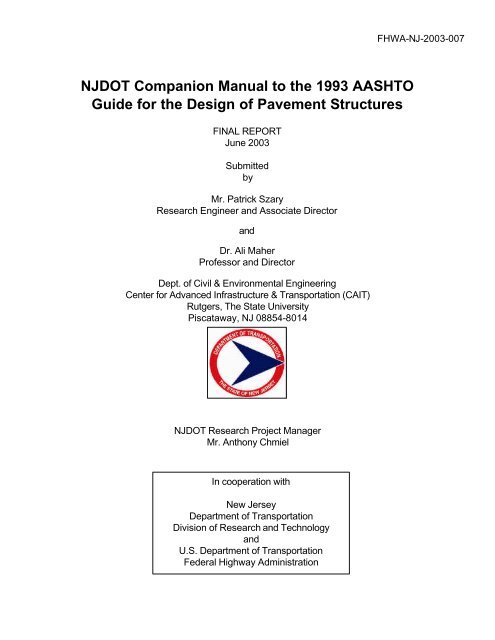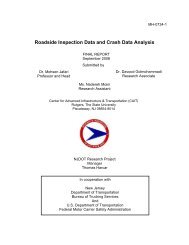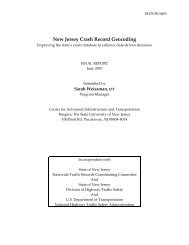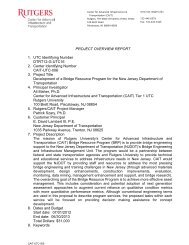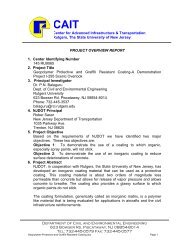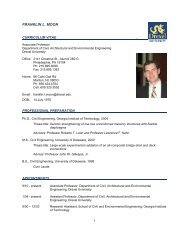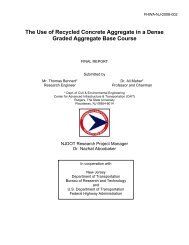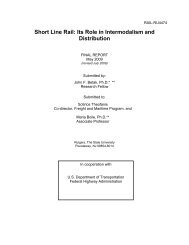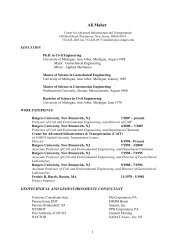NJDOT Companion Manual to the 1993 AASHTO Guide for ... - CAIT
NJDOT Companion Manual to the 1993 AASHTO Guide for ... - CAIT
NJDOT Companion Manual to the 1993 AASHTO Guide for ... - CAIT
Create successful ePaper yourself
Turn your PDF publications into a flip-book with our unique Google optimized e-Paper software.
FHWA-NJ-2003-007<br />
<strong>NJDOT</strong> <strong>Companion</strong> <strong>Manual</strong> <strong>to</strong> <strong>the</strong> <strong>1993</strong> <strong>AASHTO</strong><br />
<strong>Guide</strong> <strong>for</strong> <strong>the</strong> Design of Pavement Structures<br />
FINAL REPORT<br />
June 2003<br />
Submitted<br />
by<br />
Mr. Patrick Szary<br />
Research Engineer and Associate Direc<strong>to</strong>r<br />
and<br />
Dr. Ali Maher<br />
Professor and Direc<strong>to</strong>r<br />
Dept. of Civil & Environmental Engineering<br />
Center <strong>for</strong> Advanced Infrastructure & Transportation (<strong>CAIT</strong>)<br />
Rutgers, The State University<br />
Piscataway, NJ 08854-8014<br />
<strong>NJDOT</strong> Research Project Manager<br />
Mr. Anthony Chmiel<br />
In cooperation with<br />
New Jersey<br />
Department of Transportation<br />
Division of Research and Technology<br />
and<br />
U.S. Department of Transportation<br />
Federal Highway Administration
Disclaimer Statement<br />
"The contents of this report reflect <strong>the</strong> views of <strong>the</strong><br />
author(s) who is (are) responsible <strong>for</strong> <strong>the</strong> facts and <strong>the</strong><br />
accuracy of <strong>the</strong> data presented herein. The contents do<br />
not necessarily reflect <strong>the</strong> official views or policies of <strong>the</strong><br />
New Jersey Department of Transportation or <strong>the</strong> Federal<br />
Highway Administration. This report does not constitute<br />
a standard, specification, or regulation."<br />
The contents of this report reflect <strong>the</strong> views of <strong>the</strong> authors,<br />
who are responsible <strong>for</strong> <strong>the</strong> facts and <strong>the</strong> accuracy of <strong>the</strong><br />
in<strong>for</strong>mation presented herein. This document is disseminated<br />
under <strong>the</strong> sponsorship of <strong>the</strong> Department of Transportation,<br />
University Transportation Centers Program, in <strong>the</strong> interest of<br />
in<strong>for</strong>mation exchange. The U.S. Government assumes no<br />
liability <strong>for</strong> <strong>the</strong> contents or use <strong>the</strong>reof.
1. Report No.<br />
FHWA-NJ-2003-007<br />
2. Government Accession No.<br />
TECHNICAL REPORT STANDARD TITLE PAGE<br />
3. Recipient’s Catalog No.<br />
4. Title and Subtitle<br />
<strong>NJDOT</strong> <strong>Companion</strong> <strong>Manual</strong> <strong>to</strong> <strong>the</strong> <strong>1993</strong> <strong>AASHTO</strong> <strong>Guide</strong> <strong>for</strong> <strong>the</strong><br />
Design of Pavement Structures<br />
7. Author(s)<br />
Mr. Patrick Szary and Dr. Ali Maher<br />
9. Per<strong>for</strong>ming Organization Name and<br />
Address<br />
New Jersey Department of Transportation<br />
CN 600<br />
Tren<strong>to</strong>n, NJ 08625<br />
12. Sponsoring Agency Name and Address<br />
Federal Highway Administration<br />
U.S. Department of Transportation<br />
Washing<strong>to</strong>n, D.C.<br />
5. Report Date<br />
June 2003<br />
6. Per<strong>for</strong>ming Organization Code<br />
<strong>CAIT</strong>/Rutgers<br />
8. Per<strong>for</strong>ming Organization Report No.<br />
FHWA-NJ-2003-007<br />
10. Work Unit No.<br />
11. Contract or Grant No.<br />
13. Type of Report and Period Covered<br />
Final Report<br />
1/01/2001 - 4/30/2002<br />
14. Sponsoring Agency Code<br />
15. Supplementary Notes<br />
16. Abstract<br />
The New Jersey Department of Transportation (<strong>NJDOT</strong>) Research Division wanted <strong>to</strong><br />
develop and implement an interactive CD-ROM as a New Jersey-specific companion<br />
manual <strong>to</strong> <strong>the</strong> <strong>1993</strong> <strong>AASHTO</strong> <strong>Guide</strong> <strong>for</strong> Design of Pavement Structures. The research<br />
team developed a framework <strong>for</strong> <strong>the</strong> companion manual that met <strong>NJDOT</strong>’s requirements.<br />
The manual chapters, sections, and procedures were set-up similar <strong>to</strong> those in <strong>the</strong> <strong>1993</strong><br />
<strong>AASHTO</strong> <strong>Guide</strong> <strong>for</strong> Design of Pavement Structures, <strong>to</strong> allow <strong>for</strong> easy referencing. New<br />
Jersey-specific values <strong>for</strong> parameters needed in <strong>the</strong> structural analysis and design of<br />
pavements were added and identified.<br />
This document outlines <strong>the</strong> requirements <strong>for</strong> a CD-ROM based Multimedia <strong>Companion</strong> <strong>to</strong><br />
<strong>the</strong> <strong>1993</strong> <strong>AASHTO</strong> <strong>Guide</strong> <strong>for</strong> Design of Pavement Structures, sponsored by <strong>NJDOT</strong> and<br />
developed by Rutgers <strong>CAIT</strong>, AID Inc. and ATC Brunswick.<br />
17. Key Words<br />
<strong>AASHTO</strong>, pavement, design, guide, companion,<br />
interactive<br />
18. Distribution Statement<br />
19. Security Classif (of this report) 20. Security Classif. (of this page) 21. No of Pages 22. Price<br />
Unclassified Unclassified 48<br />
Form DOT F 1700.7 (8-69)
Acknowledgements<br />
The authors wish <strong>to</strong> express <strong>the</strong>ir appreciation <strong>to</strong> <strong>the</strong> New Jersey Department of<br />
Transportation <strong>for</strong> <strong>the</strong> allotment of funds making this research possible. Special thanks are<br />
extended <strong>to</strong> Mr. Nicholas Vitillo and Mr. Anthony Chmiel of <strong>the</strong> <strong>NJDOT</strong> <strong>for</strong> <strong>the</strong>ir support and<br />
extending <strong>the</strong> opportunity <strong>to</strong> participate in such a significant and extensive research<br />
program. The authors would also like <strong>to</strong> thank Kaz Tabrizi of Advanced Infrastructure<br />
Design (AID) and Advanced Technology Concepts (ATC) of Hoboken, New Jersey <strong>for</strong> <strong>the</strong>ir<br />
programming ef<strong>for</strong>ts.<br />
ii
TABLE OF CONTENTS<br />
Page<br />
Abstract.........................................................................................................................................1<br />
Background...................................................................................................................................1<br />
Features and Goals .....................................................................................................................2<br />
Features of Application...........................................................................................................2<br />
Goals of Application.................................................................................................................2<br />
Description of Environments...................................................................................................2<br />
General Constraints.....................................................................................................................3<br />
Software Requirements...............................................................................................................4<br />
Use Case Specification..............................................................................................................7<br />
Starting <strong>the</strong> Application...........................................................................................................7<br />
Following <strong>the</strong> Links...................................................................................................................7<br />
Moving Back.............................................................................................................................7<br />
Invoking Help Page..................................................................................................................7<br />
Quitting <strong>the</strong> Application............................................................................................................7<br />
Conclusion....................................................................................................................................8<br />
Appendix Flow Diagrams of CD Content..................................................................................9<br />
MAIN PAGE (<strong>NJDOT</strong> COMPANION MANUAL & DESIGN GUIDE)..................................9<br />
FLEXIBLE PAVEMENT DESIGN....................................................................................... 11<br />
RIGID PAVEMENT DESIGN ............................................................................................... 12<br />
FLEXIBLE OVERLAY DESIGN .......................................................................................... 13<br />
RIGID OVERLAY DESIGN................................................................................................... 14<br />
COMPOSITE OVERLAY DESIGN...................................................................................... 15<br />
ASPHALT PAVEMENT REPAIR........................................................................................ 16<br />
RIGID PAVEMENT REPAIR................................................................................................ 17<br />
PLANNED REHABILITATION ............................................................................................. 18<br />
RIVID PAVEMENT DIMENSIONING .................................................................................. 19<br />
TRAFFIC DESIGN REQUIREMENTS................................................................................ 20<br />
EXISTING EFFECTIVE STRUCTURAL NUMBER, SN EFF .............................................. 21<br />
FLEXIBLE OVERLAY DIMENSIONING............................................................................. 22<br />
FLEXIBLE PAVEMENT DIMENSIONING.......................................................................... 23<br />
LAYERS AND LAYER COEFFICIENTS ............................................................................ 24<br />
SUBGRADE MODULUS OF REACTION, K ..................................................................... 25<br />
ESAL...................................................................................................................................... 26<br />
DIRECTIONAL DISTRIBUTION........................................................................................... 27<br />
LANE DISTRIBUTION........................................................................................................... 27<br />
EFFECTIVE ROADBED RESILIENT MODULUS, M R ..................................................... 28<br />
EXISTING LAYERS AND LAYER COEFFICIENTS ......................................................... 29<br />
PERFORMANCE AND ANALYSIS PERIOD .................................................................... 30<br />
SERVICEABILITY LOSS, PSI........................................................................................... 30<br />
STANDARD DEVIATION, S 0 ............................................................................................... 30<br />
SUPERPAVE LAYER INFORMATION............................................................................... 31<br />
LABORATORY M R DATA .................................................................................................... 32<br />
NJ REGIONAL SEASON LENGTH .................................................................................... 34<br />
iii
RELIABILITY, R...................................................................................................................... 35<br />
LABORATORY RESILIENT MODULUS AND ELASTIC K-VALUE ............................... 36<br />
Appendix Images from CD-ROM ............................................................................................ 37<br />
LIST OF FIGURES<br />
Figure 1 Access Scheme............................................................................................................3<br />
Figure 2 Cover of CD-ROM Jewel Case................................................................................ 37<br />
Figure 3 Label on CD-ROM..................................................................................................... 38<br />
Figure 4 Opening Navigation Screen (interactive menu <strong>to</strong> guide <strong>the</strong> pavement engineer<br />
through <strong>the</strong> design process)............................................................................................. 39<br />
Figure 5 Submodule, <strong>the</strong> boxes with <strong>the</strong> <strong>NJDOT</strong> logo in <strong>the</strong> right corner have additional<br />
New Jersey-specific in<strong>for</strong>mation (NJ parameters can be obtained by clicking on <strong>the</strong><br />
box with <strong>the</strong> <strong>NJDOT</strong> logos)............................................................................................... 40<br />
Figure 6 New Jersey-specific parameters (note how <strong>the</strong> in<strong>for</strong>mation is dislayed based on<br />
whe<strong>the</strong>r <strong>the</strong> project is “north of I-78 and west of I-287).................................................. 41<br />
Figure 7 Example Page (<strong>the</strong>re are three design examples provided as part of <strong>the</strong><br />
software)............................................................................................................................. 42<br />
LIST OF TABLES<br />
Table 1 Definitions .......................................................................................................................v<br />
Table 2 Acronyms .......................................................................................................................vi<br />
Table 3 Functional Requirements...............................................................................................4<br />
Table 4 Per<strong>for</strong>mance Requirements..........................................................................................5<br />
Table 5 Interface Requirements..................................................................................................5<br />
Table 6 Test Requirements.........................................................................................................6<br />
Table 7 Documentation Requirements......................................................................................6<br />
iv
Definition<br />
Application<br />
User<br />
Page<br />
Main Page<br />
Help Page<br />
Examples Page<br />
Control<br />
But<strong>to</strong>n<br />
Module<br />
Main Module<br />
Submodule<br />
Instruction<br />
Question<br />
Book<br />
CD<br />
Table 1 Definitions<br />
Description<br />
<strong>NJDOT</strong> <strong>Companion</strong> <strong>Manual</strong> <strong>to</strong> <strong>the</strong> <strong>1993</strong> <strong>AASHTO</strong> <strong>Guide</strong> <strong>for</strong> <strong>the</strong><br />
Design of Pavement Structures<br />
Person, who runs <strong>the</strong> application and works with it<br />
Graphical page with controls readable and accessible by users<br />
The page <strong>the</strong> application starts from<br />
Window with help message<br />
Window with examples<br />
Anything that can be placed on a page including text messages,<br />
but<strong>to</strong>ns, images, edit fields, check boxes, radio but<strong>to</strong>ns, etc.<br />
Graphical sign or text message which is <strong>the</strong> only way of interaction<br />
between users and application<br />
Logical set of instructions and questions consisting of one or more<br />
pages<br />
Module located on <strong>the</strong> Main Page<br />
Any module except Main Module<br />
Text message in<strong>for</strong>ming users what <strong>to</strong> do<br />
Text message asking users about <strong>the</strong>ir selection with two or more<br />
available but<strong>to</strong>ns<br />
<strong>1993</strong> <strong>AASHTO</strong> <strong>Guide</strong> <strong>for</strong> <strong>the</strong> Design of Pavement Structures<br />
A compact disk with <strong>the</strong> Application<br />
v
Table 2 Acronyms<br />
Acronym<br />
<strong>NJDOT</strong><br />
Rutgers <strong>CAIT</strong><br />
AID<br />
ATC BRUNSWICK<br />
LCCA<br />
PCCP<br />
HMA<br />
AADT<br />
ESAL<br />
FWD<br />
SN eff<br />
SN<br />
LDF<br />
DCP<br />
CBR<br />
M R<br />
NJ<br />
HWY<br />
Description<br />
New Jersey Department of Transportation<br />
Center <strong>for</strong> Advanced Infrastructure & Transportation Rutgers, The<br />
State University<br />
Advanced Infrastructure Design (<strong>the</strong> Company hired <strong>to</strong> develop<br />
<strong>the</strong> Application Content)<br />
Advanced Technology Concepts (<strong>the</strong> Company hired <strong>to</strong><br />
develop <strong>the</strong> Application)<br />
Life Cycle Cost Analysis<br />
Portland Cement Concrete Pavement<br />
Hot Mix Asphalt<br />
Average Annual Daily Traffic<br />
Equivalent Single Axle Load<br />
Falling Weight Deflec<strong>to</strong>meter<br />
Effective Structural Number<br />
Structural Number<br />
Lane Distribution Fac<strong>to</strong>r<br />
Dynamic Cone Penetrometer<br />
Cali<strong>for</strong>nia Bearing Ratio<br />
Resilient Modulus<br />
New Jersey<br />
Highway<br />
vi
ABSTRACT<br />
The New Jersey Department of Transportation (<strong>NJDOT</strong>) Research Division wanted <strong>to</strong><br />
develop and implement an interactive CD-ROM as a New Jersey-specific companion<br />
manual <strong>to</strong> <strong>the</strong> <strong>1993</strong> <strong>AASHTO</strong> <strong>Guide</strong> <strong>for</strong> Design of Pavement Structures. The research<br />
team developed a framework <strong>for</strong> <strong>the</strong> companion manual that met <strong>NJDOT</strong>’s requirements.<br />
The manual chapters, sections, and procedures were set-up similar <strong>to</strong> those in <strong>the</strong> <strong>1993</strong><br />
<strong>AASHTO</strong> <strong>Guide</strong> <strong>for</strong> Design of Pavement Structures, <strong>to</strong> allow <strong>for</strong> easy referencing. New<br />
Jersey-specific values <strong>for</strong> parameters needed in <strong>the</strong> structural analysis and design of<br />
pavements were added and identified.<br />
This document outlines <strong>the</strong> requirements <strong>for</strong> a CD-ROM based Multimedia <strong>Companion</strong> <strong>to</strong><br />
<strong>the</strong> <strong>1993</strong> <strong>AASHTO</strong> <strong>Guide</strong> <strong>for</strong> Design of Pavement Structures, sponsored by <strong>NJDOT</strong> and<br />
developed by Rutgers <strong>CAIT</strong>, AID Inc. and ATC Brunswick.<br />
BACKGROUND<br />
Many organizations are faced with an increasing need <strong>for</strong> training, despite substantial<br />
reduction in <strong>the</strong>ir training budgets. As a result, training professionals are looking <strong>for</strong><br />
alternative approaches <strong>to</strong> meet <strong>the</strong>ir training needs. One alternative, which is gaining<br />
broad acceptance, is multi-media training, delivered in such mediums as CD-ROMs. This<br />
technology has been evolving over <strong>the</strong> last decade and is now at a stage that it can be<br />
used efficiently <strong>for</strong> real-time applications. The driving <strong>for</strong>ces <strong>for</strong> this technology are at<br />
present, <strong>the</strong> multi-media technology <strong>for</strong> course content generation and presentation, and<br />
<strong>the</strong> Internet as <strong>the</strong> on-line course delivery system.<br />
<strong>NJDOT</strong> personnel and pavement design consultants were used <strong>to</strong> determine New Jerseyspecific<br />
values <strong>for</strong> parameters needed in <strong>the</strong> structural analysis and design of pavements.<br />
The primary parameters of interest were those related <strong>to</strong> traffic, material characterization,<br />
subgrade characteristics, seasonal variation of material properties, and rehabilitation<br />
considerations. Specifically, design parameters included:<br />
• Initial serviceability <strong>for</strong> different pavement types and classes<br />
• Terminal serviceability <strong>for</strong> different pavement types and classes<br />
• Reliability level different pavement types and classes<br />
• Overall standard deviation <strong>for</strong> different pavement types and classes<br />
• Seasonal adjustment fac<strong>to</strong>rs<br />
• Layer coefficients <strong>for</strong> different material types<br />
• Back calculation subgrade correction fac<strong>to</strong>rs<br />
• PCC effective thickness parameters<br />
The CD companion guide <strong>for</strong> <strong>the</strong> structural analysis of pavements utilized an “objectiveoriented”<br />
approach. This approach guides <strong>the</strong> designer based on his/her objective and <strong>the</strong><br />
1
available data at-hand. In this manner, <strong>the</strong> user is guided through <strong>the</strong> companion manual<br />
without exposure <strong>to</strong> irrelevant design procedures and/or steps.<br />
This project developed and delivered a multi-purpose, multi-media based, CD-ROM<br />
<strong>Companion</strong> <strong>to</strong> <strong>the</strong> <strong>1993</strong> <strong>AASHTO</strong> <strong>Guide</strong> <strong>for</strong> Design of Pavement Structures. As previously<br />
indicated, cus<strong>to</strong>mizing and standardizing <strong>the</strong> <strong>AASHTO</strong> design procedure <strong>to</strong> reflect New<br />
Jersey conditions was a priority task.<br />
FEATURES AND GOALS<br />
Features of Application<br />
- Application is a CD-ROM based e-learning <strong>to</strong>ol.<br />
- Application is a CD-ROM based guide with but<strong>to</strong>ns between pages and choices<br />
- Application is interactive.<br />
Goals of Application<br />
- The objective of <strong>the</strong> NJ <strong>Companion</strong> <strong>Manual</strong> is <strong>to</strong> provide pavement designers with<br />
step-by-step instructions <strong>for</strong> <strong>NJDOT</strong> application of <strong>the</strong> <strong>1993</strong> <strong>AASHTO</strong> <strong>Guide</strong> <strong>for</strong> <strong>the</strong><br />
Design of Pavement Structures.<br />
Description of Environments<br />
- The <strong>Manual</strong> is intended <strong>to</strong> be used by Pavement Design Engineers.<br />
- The Application will work in a P.C. based environment.<br />
- The Application will be run from local CD-ROM, local hard drive or network file<br />
server.<br />
2
GENERAL CONSTRAINTS<br />
Access model <strong>to</strong> <strong>the</strong> guide is presented below:<br />
Figure 1 Access Scheme<br />
3
SOFTWARE REQUIREMENTS<br />
Id<br />
FR_001<br />
FR_002<br />
FR_003<br />
FR_004<br />
FR_005<br />
FR_006<br />
FR_007<br />
FR_008<br />
FR_009<br />
FR_010<br />
FR_011<br />
FR_012<br />
FR_013<br />
FR_014<br />
FR_015<br />
FR_016<br />
FR_017<br />
FR_018<br />
FR_019<br />
FR_020<br />
FR_021<br />
FR_022<br />
Table 3 Functional Requirements<br />
Description<br />
Application should be a graphical electronic guide <strong>to</strong> <strong>NJDOT</strong> application of<br />
<strong>the</strong> <strong>AASHTO</strong> <strong>1993</strong> guidelines<br />
Application should be run from local CD-ROM, local hard drive and network<br />
file server<br />
Application should be delivered on a CD-ROM<br />
Application will consist of one or more pages<br />
Application should start from <strong>the</strong> page called Main Page<br />
Application should guide users through <strong>AASHTO</strong> <strong>1993</strong> <strong>Guide</strong> <strong>for</strong> <strong>the</strong> Design<br />
of Pavement Structures<br />
Application should give users references <strong>to</strong> <strong>the</strong> Book<br />
Application should instruct users if <strong>the</strong>re is only one path available<br />
If <strong>the</strong> path of <strong>the</strong> guide divides in<strong>to</strong> two or more paths, Application should ask<br />
questions <strong>to</strong> users about <strong>the</strong>ir selection<br />
Users should follow <strong>the</strong> path by clicking but<strong>to</strong>ns<br />
Users should be able <strong>to</strong> click only allowed but<strong>to</strong>ns<br />
Disallowed but<strong>to</strong>ns should be disabled or hidden<br />
Users should be able <strong>to</strong> invoke context-sensitive help by clicking “Help”<br />
but<strong>to</strong>n<br />
Users should be able <strong>to</strong> return <strong>to</strong> <strong>the</strong> previous page by clicking “Back” but<strong>to</strong>n<br />
Users should be able <strong>to</strong> return <strong>to</strong> <strong>the</strong> Main Page by clicking “Home” but<strong>to</strong>n<br />
Users should be able <strong>to</strong> choose path by clicking corresponding but<strong>to</strong>ns<br />
Users should be able <strong>to</strong> quit Application by clicking “Exit” but<strong>to</strong>n<br />
Instructions and questions should be divided in<strong>to</strong> logical Modules<br />
Each module should consist of one or more pages<br />
Main Module should be on <strong>the</strong> Main Page<br />
Submodules should be entered and returned from as whole entities<br />
Users should be able <strong>to</strong> print pages by clicking “Print” but<strong>to</strong>n<br />
4
FR_023<br />
FR_024<br />
Users should be able <strong>to</strong> invoke page with examples by clicking “Examples”<br />
but<strong>to</strong>n<br />
Help Page should be shown every time <strong>the</strong> application is run<br />
Id<br />
PR_001<br />
Table 4 Per<strong>for</strong>mance Requirements<br />
Description<br />
After inserting <strong>the</strong> CD-ROM, <strong>the</strong> delay between beginning of loading and starting<br />
<strong>the</strong> application should not exceed 15 seconds (local CD-ROM only)<br />
PR_002 The delay between user’s click on <strong>the</strong> but<strong>to</strong>n and transition should not exceed 1<br />
second<br />
Id<br />
IR_001<br />
IR_002<br />
IR_003<br />
IR_004<br />
IR_005<br />
IR_006<br />
IR_007<br />
IR_008<br />
IR_009<br />
IR_010<br />
Table 5 Interface Requirements<br />
Description<br />
Application should have attractive and intuitive interface<br />
Window header should display application name and <strong>the</strong> current submodule (or<br />
just application name if Main Module)<br />
Application name should be on each page<br />
Submodule name should be on each page of submodule<br />
Instructions and questions should attract attention of users<br />
Text messages of different types (window headers, application name, module<br />
names, instructions and questions) should be different in style, font and color<br />
Mouse pointer should change its look when pointing <strong>to</strong> a but<strong>to</strong>n<br />
Available but<strong>to</strong>ns should differ from unavailable<br />
But<strong>to</strong>ns “Exit”, “Help”, “Home”, “Print”, “Examples” and “Back” should differ from<br />
those that allow users <strong>to</strong> select from multiple choices<br />
But<strong>to</strong>ns that point <strong>to</strong> ano<strong>the</strong>r selection on <strong>the</strong> same page, <strong>to</strong> ano<strong>the</strong>r page and<br />
<strong>to</strong> ano<strong>the</strong>r module, should clearly differ from each o<strong>the</strong>r<br />
5
Id<br />
TR_001<br />
TR_002<br />
TR_003<br />
Table 6 Test Requirements<br />
Description<br />
Quality Assurance must be carried out by ATC Brunswick, Rutgers <strong>CAIT</strong><br />
and <strong>NJDOT</strong>.<br />
Bugs found during QA will be reported <strong>to</strong> ATC Brunswick and fixed prior <strong>to</strong><br />
<strong>the</strong> Release<br />
Bugs reported after <strong>the</strong> Product Release will be fixed in subsequent<br />
Releases, if any.<br />
Id<br />
DR_001<br />
DR_002<br />
DR_003<br />
DR_004<br />
Table 7 Documentation Requirements<br />
Description<br />
Instructions on how <strong>to</strong> run CD-ROM and <strong>the</strong> System Requirements must<br />
be published on <strong>the</strong> CD-ROM jewel case insert.<br />
Main Page should have a but<strong>to</strong>n “Help” with link <strong>to</strong> a Help page where<br />
application functionalities will be described<br />
Frequently Asked Questions file will be generated based on cus<strong>to</strong>mer<br />
feedback and available online via Internet.<br />
All available in<strong>for</strong>mation will also be published on CD-ROMs and <strong>the</strong><br />
Internet with every new release<br />
DR_005 The title text on CD cover should be “<strong>NJDOT</strong> <strong>Companion</strong> <strong>to</strong> <strong>the</strong> <strong>1993</strong><br />
<strong>AASHTO</strong> <strong>Guide</strong> <strong>for</strong> Design of Pavement Structures”.<br />
6
USE CASE SPECIFICATION<br />
Starting <strong>the</strong> Application<br />
• User inserts <strong>the</strong> CD-ROM in<strong>to</strong> <strong>the</strong> CD-ROM drive<br />
• Help Page is opened <strong>to</strong> describe <strong>the</strong> usage of <strong>the</strong> application.<br />
• After a user closes Help Page, Main Page is displayed and <strong>the</strong> application awaits<br />
user’s selection.<br />
Following <strong>the</strong> Links<br />
• User clicks on one of <strong>the</strong> available but<strong>to</strong>ns on a page<br />
• Application shows/enables available path if it is on <strong>the</strong> same page, or<br />
• If <strong>the</strong> path follows <strong>to</strong> o<strong>the</strong>r page, application opens it<br />
Moving Back<br />
• User clicks “Back” but<strong>to</strong>n <strong>to</strong> return <strong>to</strong> <strong>the</strong> previous page, or<br />
• User clicks “Home” but<strong>to</strong>n <strong>to</strong> return <strong>to</strong> <strong>the</strong> Home Page, or<br />
• User clicks highlighted but<strong>to</strong>n <strong>to</strong> get back <strong>to</strong> <strong>the</strong> previous selection<br />
Invoking Help Page<br />
• User clicks “Help” but<strong>to</strong>n and <strong>the</strong> Help Page will appear with description of usage.<br />
Quitting <strong>the</strong> Application<br />
• User clicks Exit but<strong>to</strong>n in <strong>the</strong> window <strong>to</strong> close <strong>the</strong> application<br />
7
CONCLUSION<br />
The <strong>NJDOT</strong> Research Division <strong>Companion</strong> <strong>Guide</strong> <strong>to</strong> <strong>the</strong> <strong>1993</strong> <strong>AASHTO</strong> <strong>Guide</strong> <strong>for</strong> Design<br />
of Pavement Structures CD-ROM project was created <strong>to</strong> develop an innovative and<br />
effective <strong>to</strong>ol <strong>to</strong> assist pavement designers with step-by-step pavement design instructions.<br />
This technology based companion product is tailored <strong>to</strong>ward individual designers,<br />
providing <strong>the</strong>m with a self-pace of usage that utilizes <strong>the</strong>ir expertise, experience, and<br />
knowledge. It is based on a multi-media system with a CD-ROM delivery mechanism. The<br />
system integrates <strong>the</strong> latest distant learning <strong>to</strong>ols capabilities, thus providing an effective,<br />
advanced and easy <strong>to</strong> use <strong>to</strong>ol <strong>for</strong> pavement design. The program, which takes advantage<br />
of interactive-based technologies, assists pavement engineers in design and provides<br />
New Jersey-specific parameters.<br />
8
APPENDIX FLOW DIAGRAMS OF CD CONTENT<br />
MAIN PAGE (<strong>NJDOT</strong> COMPANION MANUAL & DESIGN GUIDE)<br />
9
FLEXIBLE PAVEMENT DESIGN<br />
11
RIGID PAVEMENT DESIGN<br />
12
FLEXIBLE OVERLAY DESIGN<br />
13
RIGID OVERLAY DESIGN<br />
14
COMPOSITE OVERLAY DESIGN<br />
15
ASPHALT PAVEMENT REPAIR<br />
16
RIGID PAVEMENT REPAIR<br />
17
PLANNED REHABILITATION<br />
18
RIVID PAVEMENT DIMENSIONING<br />
19
TRAFFIC DESIGN REQUIREMENTS<br />
20
EXISTING EFFECTIVE STRUCTURAL NUMBER, SN EFF<br />
21
FLEXIBLE OVERLAY DIMENSIONING<br />
22
FLEXIBLE PAVEMENT DIMENSIONING<br />
23
LAYERS AND LAYER COEFFICIENTS<br />
24
SUBGRADE MODULUS OF REACTION, K<br />
25
ESAL<br />
26
DIRECTIONAL DISTRIBUTION<br />
Use D D = 0.5 unless o<strong>the</strong>rwise directed by <strong>NJDOT</strong>.<br />
LANE DISTRIBUTION<br />
Use <strong>the</strong> following Table unless o<strong>the</strong>rwise directed by <strong>NJDOT</strong><br />
No. of Lanes in Each<br />
Direction<br />
D L<br />
1 100%<br />
2 100%<br />
3 80%<br />
4 75%<br />
27
EFFECTIVE ROADBED RESILIENT MODULUS, M R<br />
28
EXISTING LAYERS AND LAYER COEFFICIENTS<br />
29
PERFORMANCE AND ANALYSIS PERIOD<br />
For High Volume Interstate Highways: Use a 30 year design & analysis life<br />
All o<strong>the</strong>rs: Use a 20 year design & analysis life<br />
SERVICEABILITY LOSS, PSI<br />
P o = Initial Serviceability Index<br />
P t = Terminal Serviceability Index<br />
PSI = Serviceability Loss = P o - P t<br />
P t<br />
P o<br />
P o<br />
Concrete<br />
HMA<br />
Interstate 3.0 4.5 4.2<br />
State NWY 2.5 4.5 4.2<br />
County 2.0 4.5 4.2<br />
Road Type<br />
STANDARD DEVIATION, S 0<br />
For HMA: Use 0.45 unless o<strong>the</strong>rwise stated by <strong>NJDOT</strong><br />
For Concrete: Use 0.35 unless o<strong>the</strong>rwise stated by <strong>NJDOT</strong><br />
30
SUPERPAVE LAYER INFORMATION<br />
31
LABORATORY M R DATA<br />
32
NJ REGIONAL SEASON LENGTH<br />
34
RELIABILITY, R<br />
Use <strong>the</strong> following values <strong>for</strong> Reliability, R, unless o<strong>the</strong>rwise stated by <strong>NJDOT</strong>:<br />
For Urban Interstate and Freeways: R=95%<br />
For Rural Interstate and Principal Arterials: R=90%<br />
For Collec<strong>to</strong>rs and Local Roadways: R=85%<br />
35
LABORATORY RESILIENT MODULUS AND ELASTIC K-VALUE<br />
Recommended labora<strong>to</strong>ry (ideal conditions) resilient modulus and elastic k-value ranges<br />
<strong>for</strong> various soil types<br />
<strong>AASHTO</strong><br />
Class<br />
Description Unified<br />
Class<br />
Dry Density (<br />
lb/ft 3 )<br />
CBR<br />
(persent)<br />
k- value<br />
(psi/in)<br />
Lab Resilient<br />
Modulus (psi)<br />
Coarse-grained soils:<br />
A-1-a, well Glavel GW,GP 125-140 60-80 300-450 10000-20000<br />
graded<br />
A-1-a, poorly<br />
120-130 35-60 300-400 10000-20000<br />
graded<br />
A-1-b Coarse sand SW 110-130 20-40 200-400 6000-15000<br />
A-3 Fine sand SP 105-120 15-25 150-300 5000-12000<br />
A-2 soils (granular materials with high fines):<br />
A-2-4, Silty gravel GM 130-145 40-80 300-500 10000-30000<br />
gravelly<br />
A-2-5,<br />
gravelly<br />
Silty sandy gravel<br />
A-2-4, sandy Silty sand SM 120-135 20-40 300-400 10000-20000<br />
A-2-5, sandy Silty gravelly<br />
sand<br />
A-2-6, Clayey gravel GC 120-140 20-40 200-450 8000-20000<br />
gravely<br />
A-2-7,<br />
gravelly<br />
Clayey sandy<br />
gravel<br />
A-2-6, sandy<br />
A-2-7, sandy<br />
Clayey sand<br />
Clayey gravelly<br />
sand<br />
SC 105-130 10-20 150-350 5000-15000<br />
Fine-grained soils:*<br />
Silt 90-105 4-8 25-165 2000-6000<br />
A-4 Silt/sand/gravel ML,OL 100-125 5-15 40-220 4000-8000<br />
mixture<br />
A-5 Poorly graded silt MH 80-100 4-8 25-190 2000-6000<br />
A-6 Plastic clay CL 100-125 5-15 25-255 2000-10000<br />
A-7-5 Moderately<br />
plastic elastic<br />
clay<br />
CL,OL 90-125 4-15 25-215 2000-10000<br />
A-7-6 Highly plastic CH,OH 80-110 3-5 40-220 4000-10000<br />
elastic clay<br />
* Elastic k-value and resilient modulus of fine-grained soil are highly dependent on degree<br />
of saturation.<br />
1 lb/ft 3 = 16.018 kg/m 3 , 1 psi/in = 0.271 kPa/mm<br />
36
APPENDIX IMAGES FROM CD-ROM<br />
Figure 2 Cover of CD-ROM Jewel Case.<br />
37
Figure 3 Label on CD-ROM.<br />
38
Figure 4 Opening Navigation Screen (interactive menu <strong>to</strong> guide <strong>the</strong> pavement engineer<br />
through <strong>the</strong> design process).<br />
39
Figure 5 Submodule, <strong>the</strong> boxes with <strong>the</strong> <strong>NJDOT</strong> logo in <strong>the</strong> right corner have additional<br />
New Jersey-specific in<strong>for</strong>mation (NJ parameters can be obtained by clicking on <strong>the</strong> box<br />
with <strong>the</strong> <strong>NJDOT</strong> logos).<br />
40
Figure 6 New Jersey-specific parameters (note how <strong>the</strong> in<strong>for</strong>mation is dislayed based on<br />
whe<strong>the</strong>r <strong>the</strong> project is “north of I-78 and west of I-287).<br />
41
Figure 7 Example Page (<strong>the</strong>re are three design examples provided as part of <strong>the</strong><br />
software).<br />
42


